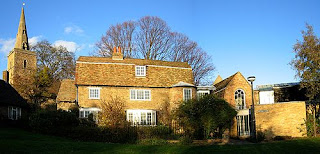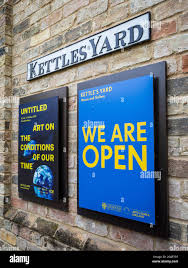 |
| Kettle's Yard, Cambridge |
In Cambridge on a U3A trip to the Cambridge Arts Theatre on Easter Saturday, after an early arrival, I decided against wandering around the centre in favour of locating Kettle’s Yard where I had spotted, online, that there was an ongoing exhibition of the work of the world-famous potter, Lucie Rie. Kettle’s Yard turned out to be a beautiful location with a generous and imaginative exhibition space plus an amazing shop, always a plus for any museum visit!! I knew my sister, Heather, used to speak warmly of visiting various exhibitions there and, though we spoke of going together, despite our best intentions, we never managed it.
 |
| Jim Ede in Kettle's Yard. Late Fifties |
 |
| Available from the shop at Kettle's Yard. Vintage poster tea towel, featuring Henri Gaudier-Brzeska's Wrestlers 1914 |
 |
| Part of the house |
 |
| The new exhibition area extends the old space in similar faultless style |
The collection itself includes works by Constantin Brancusi; William Congdon; Helen Frankenthaler; Henri Gaudier-Brzeska; Ian Hamilton Finlay; Barbara Hepworth; David Jones; Joan Miro; Henry Moore; Ben Nicholson; David Peace; Winifred Nicholson; Alfred Wallis; Christopher Wood. A litany of the early Twentieth century greats of the art world.
In addition to these formally-recognised treasures, are the famous ‘pebbles’ of Jim Ede. He particularly loved ‘objets trouves’ and fell in love with pebbles from beach and stream and river with a passion, avidly collecting these all his life. Spiral of Stones is an arrangement of 76 circular pebbles, carefully positioned by the creator of Kettle’s Yard himself. This demonstrates the importance of found and natural objects at Kettle’s Yard, which can be seen in
varying arrangements throughout the house. He felt that people make personal connections to the colour, shape or pattern of pebbles or stones that they pick up. He wrote:“I will discard 10,000 in my search for one whose outward shapes exactly balances my idea of what a pebble is ……. you may search a wide seashore or the reaches of many a river and never find one, then suddenly, it lies before you, an ordered unit, shaped of this order, from the countless vicissitudes of nature’s course…… We find a perfect pebble once in a generation, once in a continent, perhaps.”
Modest footnote:
I have collected pebbles and small stones throughout my life. It must be said, in a much less demanding way than Jim Ede did. His was of a higher magnitude and standard altogether but, nonetheless, my touchstones were the colour and shape, and overall artistic appeal to my eye. When I moved to Bruges, I had hundreds and valiantly discarded many. Moving to Bury with its significant downsizing has meant the decimation of my lovely collection, now in single numbers. One does not know the magnitude of the difficult decisions of higher ageing until one staggers up there!!







No comments:
Post a Comment